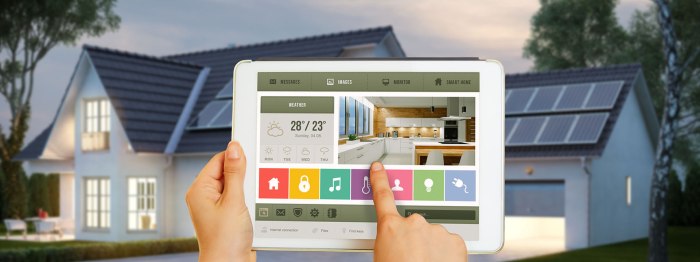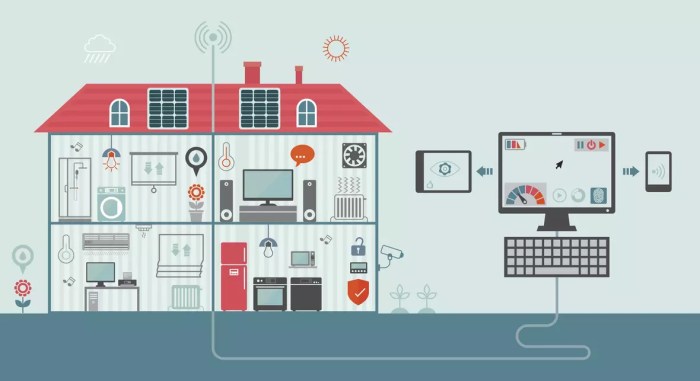In the era of automation and connectivity, smart home systems have emerged as a revolutionary way to enhance convenience, security, and energy efficiency. As homeowners embrace the allure of smart technology, understanding the cost of installing a smart home system becomes paramount.
This comprehensive guide delves into the intricacies of smart home system installation costs, providing a detailed breakdown of hardware components, professional installation fees, ongoing expenses, and potential return on investment. By exploring these aspects, homeowners can make informed decisions about implementing smart home technology that aligns with their needs and budget.
Initial Considerations

The cost of installing a smart home system varies based on several factors, including system complexity, customization, and professional installation fees. Understanding these factors helps homeowners make informed decisions and budget appropriately for their smart home projects.
The complexity of the smart home system significantly influences the overall cost. A basic system with limited features and devices will typically be less expensive than a more sophisticated system with extensive functionality and device integration. Additionally, customization plays a crucial role in determining the cost.
A system tailored to specific needs and preferences, such as custom programming or unique device configurations, will likely incur higher costs compared to a standard, off-the-shelf system.
Professional Installation vs. DIY
The choice between professional installation and do-it-yourself (DIY) approaches also affects the cost. Professional installation ensures proper setup, configuration, and integration of the smart home system. While it may involve higher upfront costs, it can save money in the long run by avoiding potential issues and ensuring optimal system performance.
DIY installation, on the other hand, can be a cost-effective option for those with technical expertise and the willingness to invest time and effort in setting up the system themselves.
Hardware Costs

Smart home systems require a variety of hardware components, ranging from basic devices to advanced sensors and controllers. The overall cost of hardware depends on the complexity of the system, the number of devices installed, and the brand and quality of the components.
Basic Hardware Components
A basic smart home system typically includes the following hardware components:
- Smart Hub: The central controller that connects all smart devices and manages communication between them.
- Smart Thermostats: Control and adjust the temperature in different rooms.
- Smart Lighting Systems: Allow remote control and scheduling of lights.
- Smart Security Cameras: Monitor the home’s interior and exterior for security purposes.
- Smart Door Locks: Enable remote locking and unlocking of doors.
- Smart Speakers: Control smart devices using voice commands and stream music.
Cost Comparison
The cost of smart devices varies widely depending on the brand, features, and quality. For example, a basic smart thermostat can range from $50 to $200, while a more advanced model with additional features like geofencing and energy monitoring can cost up to $300 or more.
Similarly, smart lighting systems can range from $20 for a single bulb to $200 or more for a complete system with multiple bulbs and controls.
Brand and Quality
The brand and quality of smart devices can significantly impact the overall hardware cost. Well-known brands like Nest, Ring, and Philips Hue tend to be more expensive than lesser-known brands. However, higher-quality devices often come with better features, reliability, and customer support, which can be worth the extra cost in the long run.
Installation Costs

Professional installation costs for smart home systems vary depending on several factors, including the complexity of the system, the number of devices being installed, and the experience of the installer.
Factors Affecting Installation Costs
- Complexity of the System: More complex systems, such as those that include multiple devices and require extensive wiring, will typically have higher installation costs.
- Number of Devices: The more devices that need to be installed, the higher the installation costs will be.
- Experience of the Installer: Experienced installers typically charge more for their services, but they may also be able to complete the installation more quickly and efficiently.
- Location of the Installation: The cost of installation may also be affected by the location of the property, such as if it is in a rural or remote area.
Labor Costs for Different Types of Smart Home Systems
- Basic Smart Home System: The labor cost for installing a basic smart home system, such as one that includes a smart thermostat, smart lights, and a smart speaker, typically ranges from $100 to $500.
- Intermediate Smart Home System: The labor cost for installing an intermediate smart home system, such as one that includes a smart security system, smart locks, and a smart garage door opener, typically ranges from $500 to $1,000.
- Advanced Smart Home System: The labor cost for installing an advanced smart home system, such as one that includes a whole-home audio system, a smart irrigation system, and a smart home theater, typically ranges from $1,000 to $5,000 or more.
Additional Fees for Installation
- Wiring: If new wiring is required for the installation of the smart home system, there may be additional fees for the wiring materials and labor.
- Setup: Some installers may charge a setup fee for configuring the smart home system and connecting it to the homeowner’s Wi-Fi network.
- Training: Some installers may also offer training on how to use the smart home system, which may come with an additional fee.
Ongoing Costs
Owning a smart home system entails ongoing costs that extend beyond the initial investment. These costs vary depending on the specific system, usage patterns, and subscription plans. It’s crucial to consider these recurring expenses to ensure the long-term affordability of your smart home.
Electricity Consumption
Smart home devices, such as smart lights, thermostats, and appliances, consume electricity when in use. The amount of electricity consumed depends on the device’s power rating and usage frequency. It’s essential to monitor energy usage to minimize electricity costs. This can be achieved by optimizing device settings, using energy-efficient devices, and scheduling device usage during off-peak hours.
Data Usage
Smart home systems often rely on internet connectivity to communicate with each other and with external services. This data usage can contribute to your monthly internet bill. The amount of data consumed depends on the number of devices, the frequency of communication, and the size of data packets being transmitted.
To manage data usage, consider using devices that support local communication protocols, optimizing device settings to minimize data transmission, and choosing an internet plan that accommodates your expected data usage.
Subscription Fees
Some smart home systems require subscription fees for cloud services, such as data storage, remote access, and advanced features. These fees vary depending on the service provider and the level of service. It’s important to evaluate the value of these services against the associated costs to determine if they are worth the investment.
Maintenance Contracts
To ensure the optimal performance and longevity of your smart home system, consider investing in a maintenance contract. These contracts typically cover regular system checkups, software updates, and repairs. The cost of a maintenance contract varies depending on the provider and the scope of services included.
While not mandatory, a maintenance contract can provide peace of mind and prevent unexpected repair costs in the future.
Return on Investment

The concept of return on investment (ROI) is crucial when considering the financial benefits of a smart home system. ROI is the ratio of the net profit or cost savings generated by an investment to the initial cost of that investment.
In the context of smart home systems, ROI can be calculated by comparing the upfront costs of installation and maintenance to the long-term cost savings and increased value of the property.Smart home systems can lead to significant cost savings in various areas, including energy consumption, security, and convenience.
For instance, smart thermostats can optimize heating and cooling systems, reducing energy usage and utility bills. Smart lighting systems can automate lighting based on occupancy and daylight, further minimizing energy consumption. Smart security systems can deter crime and provide peace of mind, potentially leading to lower insurance premiums.Several
factors influence the ROI of a smart home system, including the size and complexity of the system, the type of smart devices installed, the energy efficiency of the home, and the local utility rates. Additionally, the initial installation costs and ongoing maintenance fees can vary depending on the chosen smart home platform and the services provided.
Budget Planning

Developing a smart home system installation budget requires careful planning and consideration of individual needs and preferences. A step-by-step guide to help homeowners estimate costs and set a realistic budget is presented below:
1. Assess Needs and Preferences
Start by identifying the primary reasons for installing a smart home system. Determine which aspects of home automation are most important, such as security, energy efficiency, convenience, or entertainment.
2. Research Smart Home Solutions
Explore various smart home products and systems available in the market. Compare features, compatibility, and user reviews to determine the best options that align with your needs and budget.
3. Create a Comprehensive List
Make a comprehensive list of all the smart home devices and components you plan to install. Include details like quantity, brand, model, and estimated cost. This list will serve as the foundation for your budget planning.
4. Prioritize Features
Prioritize smart home features based on their importance and urgency. Allocate a larger portion of your budget to essential features while considering additional features as optional upgrades.
5. Set a Realistic Budget
Set a realistic budget that aligns with your financial capabilities and the value you expect from the smart home system. Remember to include not only the upfront costs but also ongoing expenses such as maintenance, subscription fees, and energy consumption.
6. Explore Cost-Saving Strategies
Look for ways to save money on smart home installation without compromising on quality. Consider purchasing refurbished or discounted devices, opting for DIY installation, or negotiating with contractors for better deals.
Final Thoughts
The cost of installing a smart home system is a multifaceted consideration that involves careful planning and budgeting. By understanding the factors that influence these costs, homeowners can optimize their smart home investments, ensuring a harmonious balance between functionality, affordability, and long-term value.
As smart home technology continues to evolve, homeowners can anticipate even greater convenience, efficiency, and peace of mind in the years to come.
Common Queries
What are the primary factors that determine the cost of installing a smart home system?
The cost of installing a smart home system is influenced by several key factors, including the complexity and customization of the system, the type of smart devices selected, the chosen installation method (professional vs. DIY), and ongoing costs such as electricity consumption, data usage, and subscription fees.
How can I estimate the cost of installing a smart home system?
To estimate the cost of installing a smart home system, homeowners can follow a step-by-step guide that involves assessing their specific needs and preferences, researching and comparing different smart home devices and installation options, and considering potential ongoing expenses. Creating a realistic budget and prioritizing smart home features based on individual requirements is essential for effective cost management.
Are there ways to save money on smart home installation without compromising on quality?
Homeowners can explore various strategies to save money on smart home installation without compromising on quality. These include opting for DIY installation (if feasible), considering less expensive smart home brands or models, taking advantage of sales or discounts, and researching potential rebates or incentives offered by utility companies or government programs.